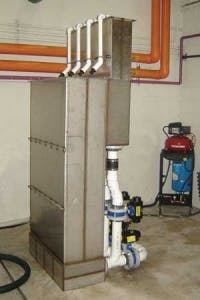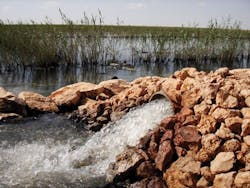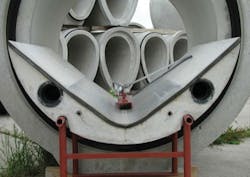By Lnsp Nagghappan
The San Ardo Oil Field, operated in two separate units by Chevron North American Exploration and Production (Chevron) and Aera Energy LLC, comprises 2,500 acres of land adjacent to the Salinas River in Monterey County. New water reclamation technology has enabled the producer to expand its current area of steam-enhanced production into idled, previously developed portions of the field.
Reverse osmosis was ultimately selected as the preferred desalination technology at San Ardo.
Steam flooding has been used continuously in the Aurignac and Lombardi sands since the 1960s. Oil production has been declining in recent years, however, due to limited capacity for disposing of the produced water that comes to the surface as part of the oil and gas extraction process. The challenge for producing the remaining heavy oil, particularly in the Lombardi formation, is to remove the excess water from the reservoir, which can range from 10 to 20 times the oil production rate.
Historically, a portion of this water has been recycled and softened to provide water for steam generation, with the remainder going to local EPA class II injection wells for disposal. However, the injection zone capacity is limited, which had constrained full field development.
Reverse Osmosis Selected
Dewatering would reduce the formation pressure and thereby allow the injected steam to contact the remaining heavy oil for production. Dewatering, in essence, would allow the area of steam-enhanced production to be expanded. In the early 1990s, several alternatives for dewatering the reservoir were evaluated and reverse osmosis (RO) was ultimately selected as the preferred desalination technology on the basis of a successful field trial conducted at San Ardo. Additional field trials and bench scale tests followed, which confirmed the results of the original field trial and verified the efficacy of the RO technology to successfully treat the produced water.
Treated water is discharged to post-treatment constructed wetlands, which act as a buffer between the desalination facilities and aquifer recharge basins.
RO membrane performance is dependent on a number of factors, including water quality, feed pressure, feed temperature, recovery, membrane construction, and the presence of contaminants that can foul or scale the membranes. San Ardo produced water contains a number of these contaminants, including free oil, water soluble organics, suspended solids, sulfides, hardness, silica, and other dissolved solids.
For RO to be successful, membrane fouling and scaling must be controlled so that recovery will be limited primarily by osmotic pressure and not by the presence of contaminants. Furthermore, the system must be sufficiently robust to handle variations in feed water quality and be capable of maximizing recovery by recycling a portion of the waste streams to the front end of the treatment process. And finally, the process must reliably treat the water to meet stringent California Waste Discharge Requirement (WDR) effluent specifications.
Because the treated effluent is discharged to a constructed wetlands, TDS and boron removal were key factors in the project. Chevron specified nearly 98% removal of boron content (< 0.64 ppm) and a 92% reduction in TDS (< 510 ppm). It was determined that the RO process - the final stage in the system - could achieve these removal levels, but it was essential that the RO feed water be properly pretreated to maximize membrane performance and minimize fouling and scaling.
Enhanced Water Reclamation
In October 2007, a desalination facility was commissioned to allow a portion of the produced water to be treated and discharged to a shallow fresh water aquifer, thereby providing an alternate outlet for produced water and allowing field development to progress.
This project is the first produced water desalination facility in the world to use OPUS™ technology, which has proven to be a reliable and robust process for successfully treating produced water for surface discharge. Portions of the technology were developed jointly and patented separately by Chevron U.S.A. and Veolia Water Solutions & Technologies.
The new desalination facility is designed to process 66,700 barrels per day of produced water with a recovery factor of 75%, which is the percentage of influent produced water that is desalinated and discharged as permit-compliant treated water. The recovery factor of 75% translates into an effluent treated water rate of 50,000 barrels per day. This particular factor was selected based on the results of bench-scale testing and economic evaluations.
Multi-media filtration helps pretreat the water before the RO step.
Construction of the produced water reclamation facility began in 2006 and full capacity was achieved in November 2007. Reclamation begins with de-oiling followed by the OPUS technology, which consists of multiple treatment processes. The treated water is discharged to post-treatment constructed wetlands and aquifer recharge basins.
System Overview
The San Ardo Field produces up to 180,000 barrels per day of water, which is treated in an oil dehydration facility to remove the bulk of the oil for sales to pipeline. The water is then transported to the water reclamation facility, where a portion is sent directly to disposal in Class II injection wells. The remainder is processed in the reclamation facility, first by induced gas flotation, followed by walnut shell filtration for the purpose of de-oiling the feed water. The de-oiled water is then treated by the OPUS technology for the conversion of produced water into water quality suitable for aquifer discharge.
This technology consists of multiple treatment steps involving cooling, degasification, chemical softening, media filtration, ion exchange softening, cartridge filtration, double-pass reverse osmosis, pH neutralization, and remineralization. The pre-treatment processes ahead of the RO membranes are designed to reduce free oil, suspended solids, hardness, and metals concentrations in the feed water. The RO process operates at elevated pH, which effectively controls biological, organic, and particulate fouling; reduces silica scaling; and increases the rejection of silica and boron.
The induced gas flotation and walnut shell filtration reduce the free oil to less than 1 ppm. The de-oiled water is cooled to reduce the feed water temperature from 200° F to 165° F, and is degasified with the addition of acid to partially remove certain dissolved gases (carbon dioxide and hydrogen sulfide) and excess alkalinity. The degasification process helps reduce the quantity of solids generated in the downstream chemical softening process and the alkali demand associated with raising the pH.
The degasified water is softened in a multi-stage chemical softening process for the removal of hardness and suspended solids. This multi-stage chemical softening process generates dense crystalline solids (6 to 10% by weight), which are settled in a clarifier and dewatered in a filter press for disposal.
The water from the multi-stage chemical softening process is cooled to 100° F and further treated with multi-media filtration, weak acid cation ion exchange softening (in sodium form), and cartridge filtration, all at elevated pH, to further reduce hardness, metals, and particulate concentrations.
The pretreated water is then pressurized through a double-pass RO system, also operated at elevated pH, to reduce the total dissolved solids (TDS), silica, boron, and organics present in the feed water. A portion of the RO permeate is used for makeup to the cooling tower to offset evaporation and blow down. The tower circulates cooling water to heat exchangers in the desalination facility to cool the produced water. The remaining permeate is neutralized with sulfuric acid and carbon dioxide, and calcium chloride is injected to control the sodium adsorption ratio, which is a measure of the water's suitability for agricultural use.
The treated water is then discharged to aquifer recharge basins via post-treatment constructed wetlands, which act as a buffer between the desalination facilities and the basins. The wetlands use a clay liner to prevent percolation of water into the aquifer and are planted with native flora, such as cattail.
Liquid wastes consisting of softener spent regenerant, reverse osmosis reject, and cooling tower blowdown are disposed in class II injection wells, and solid wastes are disposed in a commercial landfill. Wastewater and sludge recycle / reuse are practiced throughout the process to maximize recovery and ensure that a minimum amount of waste is generated.
System Performance
The multiple-treatment OPUS process is removing contaminants sufficiently to meet the requirements for discharge into the shallow wetlands basins.
Specifically, the technology is very efficient in TDS removal, achieving a water quality that exceeds the target of 510 ppm TDS with an effluent containing only <120 ppm TDS. Similarly, the boron content of the treated effluent has been significantly lower than the specification. The effluent water quality comfortably meets the effluent specifications, particularly for TDS, sodium, chloride, nitrate, and boron.
The feed water and permeate flow rates from the RO skids have also been consistent, resulting in a constant recovery of 80.5% in the first pass and 90% in the second pass. Feedwater conductivity (which is a proxy for TDS into the first pass RO membranes) has risen 6-8% since startup, and this increase has been mirrored by a corresponding rise in first pass feed water pressure and permeate conductivity. Despite these changes, however, salt passage through the first pass RO membranes has remained stable at ~3.5% and the second pass feedwater pressure and permeate conductivities have not increased. Most remarkably, salt passage through the second pass membranes has declined.
The first pass RO membranes have rarely needed cleaning. Typical cleaning frequencies are once every three to six months. The second pass RO membranes have never been cleaned.
About the Author: Lnsp "Naggs" Nagghappan is Director of Business Development, Oil & Gas, for Veolia Water Solutions & Technologies. Veolia Water Solutions & Technologies (VWS) serves the upstream oil and gas industry by providing the complete range of water and wastewater solutions, including feasibility and compliance studies, advanced water and wastewater treatment technologies and turnkey installations.Past IWW Issues





